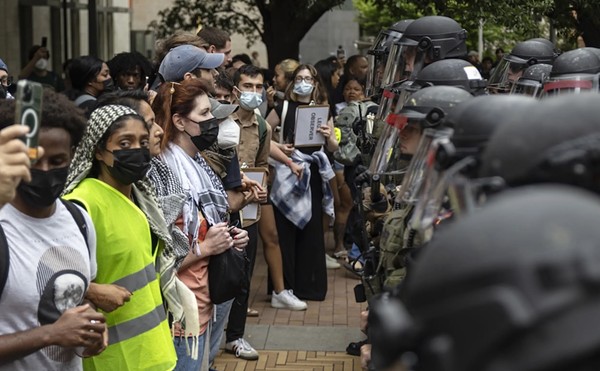A man walks along a beach littered with millions of stranded starfish. He stoops from time to time to pick one up and throw it back into the ocean. Another man approaches and says, “Don’t you realize that there are miles and miles of beach, and stranded starfish all along it? You can’t possibly make a difference!” The first man listens politely and then bends down, picks up another, and casts it back beyond the breaking waves. “It made a difference to that one.”
Ted White, the protestant chaplain of the Bexar County Jail, recounts this allegory, alluding to his work to rehabilitate inmates that suffer substance-abuse problems. Of these there are many. The jail is a city unto itself, with more than 3,500 men and women incarcerated on average on any given day. Around 85 percent are in for some kind of drug-related offense, a majority of which are nonviolent.
Three weeks ago, we disputed the conventional wisdom that trafficking clashes among Mexican drug cartels had led to the spillover of violence, crime, and syndicated cartel cells in our city. `See “A dry spillover,” May 18, at sacurrent.com.` But Mexico remains the most important transit nation for illegal drugs introduced into the United States, a grim reality currently manifesting itself in the catastrophic body count south of the border.
Like all metropolitan areas, San Antonio is home to a large population of drug users and addicts. Despite proximity to the border, however, San Antonio does not exhibit higher abuse patterns than the rest of Texas. According to a March report from the San Antonio Council on Alcohol and Drug Abuse, the most recent data from the 2006 Texas School Survey of Drug and Alcohol Use in Bexar County document a 2-percent lifetime use of heroin among secondary students, equal to 2 percent in Texas as a whole. For cocaine, the levels are even at 7 percent each. Our marijuana use is even lower, comparatively: 25 percent in Bexar County versus 30 percent in Texas as a whole.
Texas, in turn, has lower abuse rates than much of the country. The 2006-’07 National Survey on Drug Use and Health estimated that 6 percent of the Texas population age 12 and older had used an illicit drug in the past month, which is below the national average of 8 percent. Texas reported a rate of 10.6 drug-related deaths per 100,000 in 2006. The rate nationwide topped out at 12.7. Addiction rates are in line with national trends, as 3 percent of Texans were estimated to be dependent on an illicit drug, compared with 3 percent nationally, but Texans, it would seem, prefer to tipple: cirrhosis deaths in the state hover at 11, versus 8.8 in the U.S. as a whole.
Whacking moles
The volume of both cocaine and methamphetamine imports into the U.S. appear to have been reduced by Washington’s aggressive border policies. Cocaine seizures at ports of entry have spiked, and in Texas the narcotic is both rising in price and falling in purity as a consequence. Imports of meth have also declined as production has been crippled in Mexico by that country’s crackdown on chemical precursors (pseudoephedrine has been banned, and smuggled pseudoephedrine has been seized in record amounts).
According to the Bexar County Medical Examiner’s Office, drug-related deaths from cocaine and methamphetamine have plunged, down 28 percent and 45 percent, respectively in 2008, the most recent year for which public figures are available. But a shortage of one drug can lead users to shift consumption habits in unpredictable and dangerous ways. Deaths in which cocaine has been mixed with heroin doubled in 2008, and heroin-related deaths without the presence of cocaine shot up by 76 percent. Overall, despite the decrease in cocaine and meth deaths, drug-related deaths rose 5 percent compared with 2007.
As the supply of high-grade meth from Mexico dwindles, authorities are now seeing a resurgence in locally manufactured low-grade speed. “I am interviewing methamphetamine users in the Austin area,” says Jane Maxwell, a senior research scientist at the Addiction Research Institute at the University of Texas at Austin. “They report there is still plenty of meth available, more local cooking, and there will be a continued need to provide treatment for these highly impaired individuals. I am seeing a shift from smoking ‘ice’ to injecting powder or ice, which is most likely a result of less availability of high-quality ice and using a less pure ice or making your own powder.”
An Ounce Of Prevention
Bexar County jail teems with drug offenders because conventional law enforcement has targeted the small-time user and the street-level dealer, punishing possession of small amounts of drugs or paraphernalia. In Texas, roughly 90 percent of all drug arrests are for possession, about half for marijuana.
This policy approach has drawn blistering criticism in recent years. Human Rights Watch reports that, “Perhaps the single greatest force behind the growth of the prison population has been the national ‘war on drugs.’” The number of incarcerated drug offenders in America has increased by more than 1,000 percent since 1980, and drug arrests have risen dramatically in that timeframe to nearly 1.5 million per year at present. Even the most hawkish Americans lose stomach when confronted with the staggering cost of maintaining the world’s largest prison population: $68.7 billion in 2006, versus $15.8 billion 20 years prior.
The cost to our society of this approach beyond the simple fiscal and judicial burden of warehousing drug offenders has been widely documented. We pay not only to incarcerate prisoners, we lose their aggregate productivity in the economy, with all of the ripple effects that entails. We upend families, often leading to a greater demand on social services. We tie up our courts and police. And when we do not address the root causes of drug abuse, the gates to the penal system become a revolving door for millions.
The National Institutes of Health estimate that every $1 invested in addiction-treatment programs yields a return of between $4 and $7 in reduced drug-related crime, criminal-justice costs, and thefts — a return that increases when health-care savings are factored in. “For every dollar we dedicate to substance-abuse prevention efforts, our community can look forward to a tenfold return on its investment,” according the San Antonio Council on Alcohol and Drug Abuse.
A policy shift to emphasize treatment and prevention is now under way in the U.S. The Office of National Drug Policy has semantically declared an end to the “war on drugs.” In May, President Barack Obama unveiled the administration’s 2010 National Drug Control Strategy, which promotes “aggressive prevention and recovery programs” to the same rhetorical prominence as “law enforcement efforts to disrupt and interdict the movement and sale of illicit drugs.” The “transformative” 2010 NDCS “takes a more comprehensive and balanced approach to the drug problem,” by heeding, “the imperatives of preventing drug use and addiction and making treatment available for those who seek recovery.”
Big Dreams, Small Hopes
People who work with substance abuse are hopeful that a shift in tack will feed through to local efforts. Mayor Julián Castro calls the Obama policy “encouraging” and told the Current through a spokesperson: “Drug abuse is a terrible illness that must be addressed on many fronts, including both treatment and enforcement.”
He points to Haven for Hope, the newly inaugurated $100-million homeless shelter that integrates housing, meals, job training, counseling, medical care, and other services in one facility. The program has yet to prove itself on paper, but adjacent to the facility, the Restoration Center, part of the downtown Center for Health Care Services, has been in operation for two years and has recorded outstanding results.
The first of its kind in the state, the Restoration Center is built around the public sobering unit, a jail and emergency-room diversion program. When cops nab intoxicated citizens in public in San Antonio, rather than cart them off to the drunk tank and then to jail, they bring them to the center, which houses 27 state-funded detox beds. There, trained medical personnel monitor their withdrawal from drugs or alcohol, and counselors entice them to enter the center’s week-long therapy-based detox program. If they are homeless (and two-thirds of intakes are) they are channeled across the lawn to the adjacent Haven for Hope to live.
“Substance abuse is a medical issue,” says Melanie Lane, director of operations for the center. “We are of the belief that recovery from substance abuse is a process; very few people get one bite of the apple and never use again. We are trying to find a better way to deal with the substance-abuse community than locking them up.” According to internal studies, the new detoxification center has saved taxpayers more than $12 million in jail, emergency-room, and court diversions since it opened last year.
San Antonio has a strong track record with these types of diversion programs. The recidivism rate among those who’ve been processed through one of the county’s drug courts is 8 percent, versus a rate among the broader jail population of 80 percent. The Bexar County Family Drug Court, which seeks to rehabilitate parents who have had children removed from their homes due to substance abuse, not only addresses substance abuse, it actually builds functional, unified families. “We surround them with an array of services,” says Charlie North, a licensed therapist for the court who is subcontracted by the Family Services nonprofit. “I have seen so many families affected in a positive way.”
But how many? This month, the Family Drug Court graduated its largest “class” in its nine-year history: 10 individuals who were successfully treated, a tiny fraction when stacked against the burgeoning population of drug offenders.
“I’ve been in this field since 1993, and the main problem has always been funding,” North says. “There never seems to be enough money that is allotted toward substance-abuse treatment, and it’s one of the areas that usually gets cut first when there’s a deficit.”
That’s bad news in today’s languid economy. If scarce funding hamstrings these groundswell initiatives in times of surplus, the scramble for monies will now only become more desperate, regardless of any empirical evidence of their fiscal payoffs. To make matters worse, the state government in Austin does not share the Obama Administration’s policy tilt toward enhancing prevention and treatment. The Therapeutic Community Treatment program started in Texas prisons in the 1990s was cut to the bare bones by ex-Governor George Bush, despite results that showed a 25 percent re-incarceration rate versus 42 percent for untreated control groups. Governor Rick Perry has not moved to restore funding, either.
“I was with the state agency for years, and the only time I have seen a significant increase in treatment capacity was when Ann Richards was governor and Bob Bullock was lieutenant governor,” says Maxwell. “Both were recovering, and there was a major push to provide treatment in the prisons and to increase treatment capacity statewide. Given the current state-funding shortage, I would not be hopeful of a massive infusion of state money. Some of the states already have problems meeting their ‘maintenance of effort’ level, which is the amount of state money which has to be used to match the federal grants.”
The recession will also hurt San Antonio’s efforts to prevent and treat substance abuse in a far more immediate way: The recent spike in joblessness will aggravate abuse and addiction patterns. We often hear that the U.S. recession has hit softer in Texas than in other states, and that San Antonio, in particular, has escaped the brunt of the downturn. To be sure, the San Antonio metropolitan area’s joblessness rate of 7.3 percent at the end of the first quarter for 2010 did look a bit better than the Texas rate of 8.2 percent, and still better than the national unemployment rate, which stood at 9.7 percent. But still, the city’s unemployment hit its highest level in more than two decades in the first three months of this year, and the ranks of its jobless ballooned by more than 20,000 in 2009.
“In 2008, 32 percent of the clients entering Department of State Health Services-funded treatment `statewide` were employed; in 2009, only 15 percent were employed,” notes Maxwell. “This will have a significant impact on the ability of individuals to graduate from treatment and find jobs and stay abstinent. I’ve had anecdotal reports from outreach workers of individuals completing treatment and trying to find jobs and are unable to, so they get bored and take up drinking and drugging again.”
When faith is All You Have
Chaplain Ted White is a problem-solver. Before coming to the Bexar County Jail 10 years ago, he was an elite corporate troubleshooter for one of the world’s largest banks, a ranking executive who parachuted into intricate financial tangles and sorted them out. Substance-abuse treatment and prevention, though, trumps any of those challenges, he says.
White tells the story of one local he met in county lockup, a man addicted to heroin and methamphetamine since his early teenage years. So severe was his addiction that after one overdose hospitalization a friend smuggled heroin into his ward. He shot up while still recovering on his cot. “When I met him in jail, he had a religious, spiritual awakening: ‘I need to get out of this life,’” White remembers.
The man began worshiping in jail, studying the Bible, and after release continued to seek guidance. White mentored him on the outside for months, helping him find work driving trucks for local charities, to relearn reading skills, to get fitted with new teeth, and to find a life partner. He has flourished. “They had prayed for him for 15 years at his church, because they thought he was going to die. Now he’s a spiritual leader there; the pastors look up to him; he’s in a job with $60,000 a year take-home and he’s engaged to be married.” That, says White, is a starfish story.
The chaplain envisions building on his successes, but he worries about both funding and the sheer lack of infrastructure. “I don’t know if we can even train the mentors we need,” he says. White’s rule of thumb is that without proper engagement upon release, in two weeks the ex-cons will fall back into familiar patterns. His other rule is that successful drug-free re-adaption requires two years of followup support. Which is why for every starfish tossed back, so many wash right back up. •


















